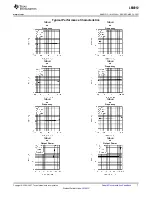
LM4910
www.ti.com
SNAS151G – MAY 2004 – REVISED MARCH 2007
USING EXTERNAL POWERED SPEAKERS
The LM4910 is designed specifically for headphone operation. Often the headphone output of a device will be
used to drive external powered speakers. The LM4910 has a differential output to eliminate the output coupling
capacitors. The result is a headphone jack sleeve that is connected to V
O3
instead of GND. For powered
speakers that are designed to have single-ended signals at the input, the click and pop circuitry will not be able
to eliminate the turn-on/turn-off click and pop. Unless the inputs to the powered speakers are fully differential the
turn-on/turn-off click and pop will be very large.
AUDIO POWER AMPLIFIER DESIGN
A 30mW/32
Ω
Audio Amplifier
Given:
Power Output
30mWrms
Load Impedance
32
Ω
Input Level
1Vrms
Input Impedance
20k
Ω
A designer must first determine the minimum supply rail to obtain the specified output power. By extrapolating
from the Output Power vs Supply Voltage graphs in the Typical Performance Characteristics section, the
supply rail can be easily found.
Since 3.3V is a standard supply voltage in most applications, it is chosen for the supply rail in this example. Extra
supply voltage creates headroom that allows the LM4910 to reproduce peaks in excess of 30mW without
producing audible distortion. At this time, the designer must make sure that the power supply choice along with
the output impedance does no violate the conditions explained in the Power Dissipation section.
Once the power dissipation equations have been addressed, the required differential gain can be determined
from Equation 2.
(3)
From Equation 2, the minimum A
V
is 0.98; use A
V
= 1. Since the desired input impedance is 20k
Ω
, and with A
V
equal to 1, a ratio of 1:1 results from Equation 1 for R
f
to R
i
. The values are chosen with R
i
= 20k
Ω
and R
f
=
20k
Ω
.
The last step in this design example is setting the amplifier's
−
3dB frequency bandwidth. To achieve the desired
±0.25dB pass band magnitude variation limit, the low frequency response must extend to at least one-fifth the
lower bandwidth limit and the high frequency response must extend to at least five times the upper bandwidth
limit. The gain variation for both response limits is 0.17dB, well within the ±0.25dB desired limit. The results are
an
f
L
= 100Hz/5 = 20Hz
(4)
and an
f
H
= 20kHz x 5 = 100kHz
(5)
As mentioned in the Selecting Proper External Components section, R
i
and C
i
create a highpass filter that
sets the amplifier's lower bandpass frequency limit. Find the coupling capacitor's value using Equation (3).
C
i
≥
1/(2
π
R
i
f
L
)
(6)
The result is
Copyright © 2004–2007, Texas Instruments Incorporated
Submit Documentation Feedback
13
Product Folder Links:
LM4910














































